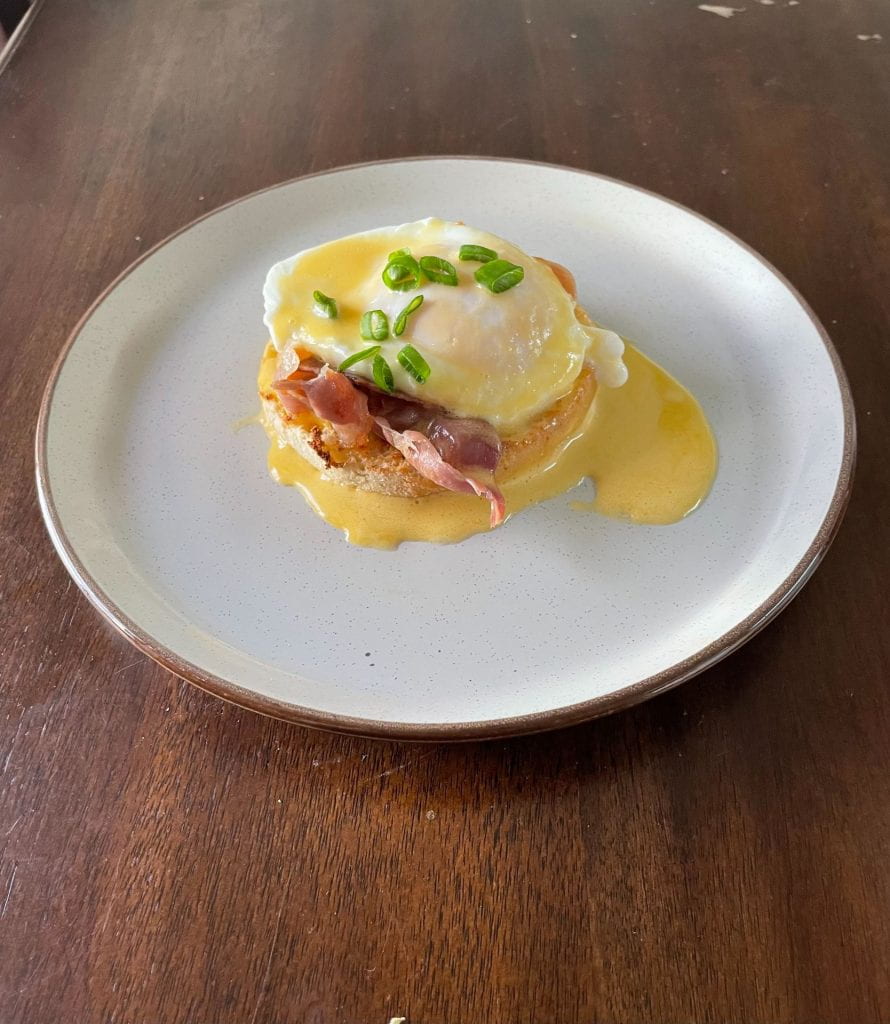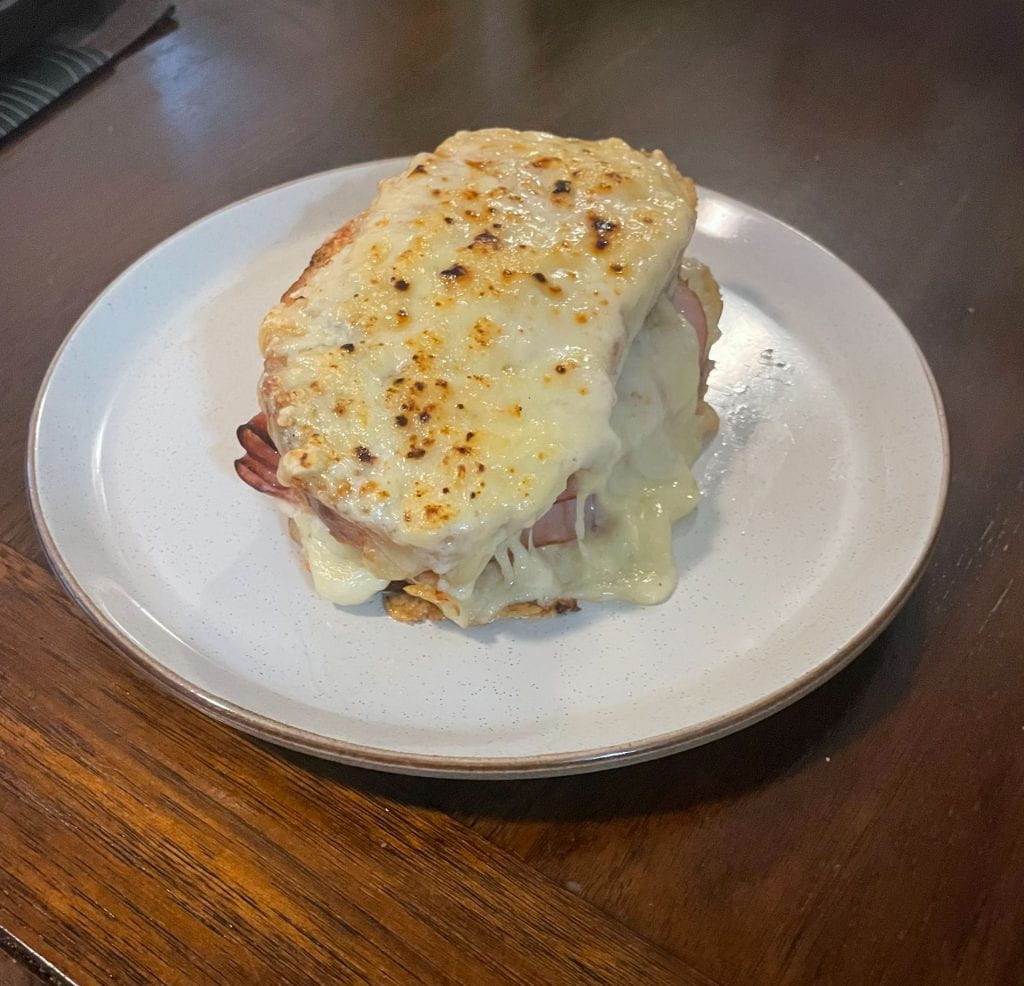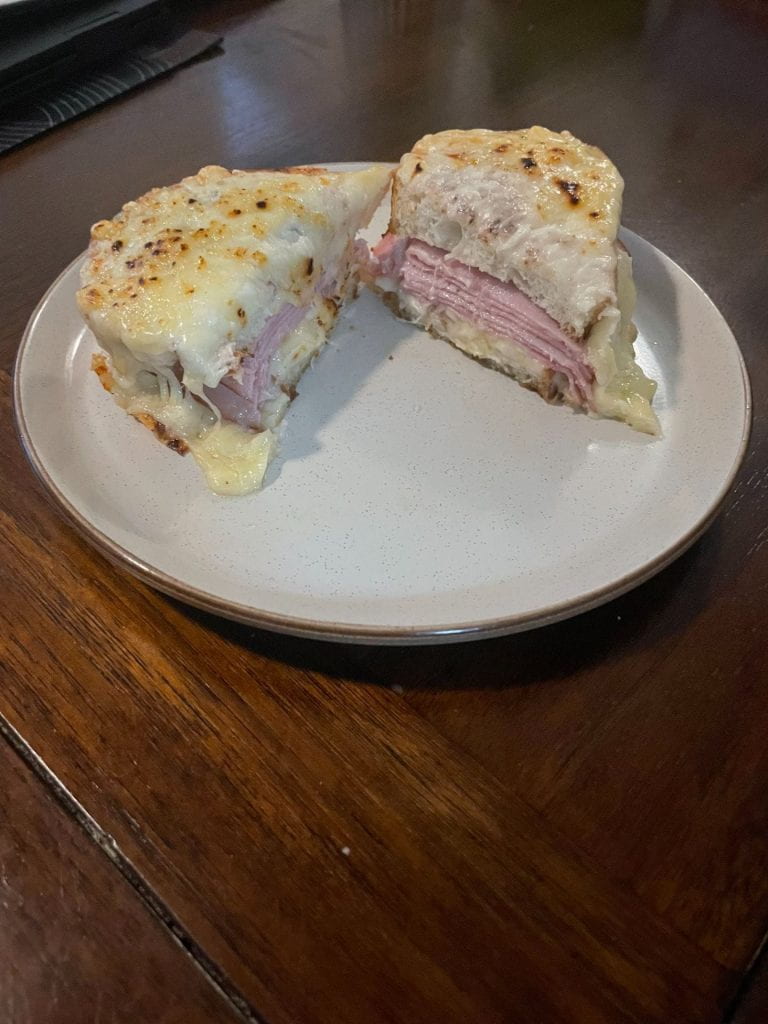In-depth blog post #3
Between the last blog post and this one, I have created 3 different dishes. Initially, I was planning on creating croque monsieur and hollandaise sauce; however, I also made crème brûlée. I decided to make crème brûlée as well because the hollandaise and croque monsieur did not end up being that difficult to make. I only met with my mentor once, and I didn’t make all three dishes during that one meeting which meant some were created on my own time. The dishes I made with my mentor were the hollandaise sauce and béchamel sauce, which is a sauce that goes into making the Croque monsieur. This does mean that my mentor was not able to taste any of the final products made with the two sauces.
Starting with the hollandaise, I found it to be quite an easy sauce to make. The hollandaise sauce is one of five French mother sauces. It is most well-known for its use in the English breakfast dish, eggs benedict, which I made as well using the hollandaise sauce. It is a savory and creamy sauce with a hint of acidity that complimented the other ingredients of eggs benedict well. It is mostly comprised of egg yolk and butter and made by the emulsification of the two. It required a lot of constant whisking because otherwise it would break and separate the sauce making it unpleasant. Despite the very basic ingredients that were required, it made a delicious sauce and was not very difficult to make. Something that my mentor shared with me is that in most restaurants, chefs use a blender to make the hollandaise sauce. The reason was that it was easy to make large batches at a time and didn’t require so much whisking. We did not do that because then I would be missing out on traditional techniques. Using a double boiler like I did cooked the eggs to a safe temperature to eat, something that a blender cannot do. As I said, I made eggs benedict with the sauce, however, that is not the main focus and is not a French dish so I will not be going into more detail.
The croque monsieur, like mentioned is made with béchamel, white bread, gruyère cheese, and ham. The béchamel, another very popular French mother sauce, was interesting to make with my mentor. I have made a béchamel a couple of times before, however, it never turned out as good as it did this time. What I noticed was that the recipe used a different ratio of ingredients added, and amount of cook time. In my past experiences, I had a higher roux to milk ratio. A roux is a 1:1 ratio of flour and butter mixture that is used to thicken sauces. Using a smaller ratio of roux to milk helped me not overcook the béchamel. Another difference in my past attempts is how long the roux is cooked. Due to butter easily burning and browning, I never focused on cooking off the flour. By not cooking off the flour, it causes the béchamel to taste very floury and less like a rich, creamy milk sauce. The difference the two listed improvements made were significant and produced a delicious sauce. To compose the rest of the dish, all I did was toast some bread, shred and add lots of gruyére, spread the béchamel sauce on the toast, and add slices of ham. I then did the same to the top of the bread except did not add any ham. I put it in the oven, and it turned out great. However, the top did not get as charred as I would have liked, so I used a torch to give it a nice char. One thing that I thought almost went wrong was with the cheese. While baking, the smell of the gruyére was very unpleasant. It smelled very old and had a very strong smell that lingered throughout my house. I even tasted the cheese beforehand as I had never had expensive cheese before, and I didn’t find the taste to be very good. Thankfully, when it was fully melted, the smell disappeared, and the smell did not affect the taste at all.
Lastly, the crème brûlée. All components were made at home by myself on my own time. It wasn’t anything that I planned with my mentor, so I made it whilst thinking of it as something to make to pass time. Surprisingly, this was not too difficult to make either. The only challenging part was how long it took to bake. It took 40 minutes of baking and time in the fridge, along with torching the top to be fully completed. Everything went very smoothly while making it, however, one issue I had was with my oven. My oven is quite old, and as time passes, the strength of the oven’s heat can become weaker. I did not test the temperature of my oven before to see how accurate it was, so the product ended up being a little looser than it should have been. Nothing was still not fully cooked, but the texture was slightly impacted. I think the height of the water bath was not as high as it should have been either. Otherwise, I thought the dish turned out successful.
Something that I noticed was the cost of the ingredients. Especially at this time, the cost of the ingredients has become very high. I pay for all ingredients myself and buying them for 3 very different dishes resulted in costs adding up. Moving forward, I am planning on either making more simpler foods that use lots of basic ingredients or only creating one special dish in between blog posts that require more expensive ingredients. I may switch between doing both depending on what my mentor suggests I make; however, I would like to make fewer foods, however, make more difficult ones because I believe that will create a challenge for me, which I enjoy.
I also decided to make some adjustments to my initial plan with these blog posts moving forward. Needing to complete many other small components, like critiquing and rating has been causing more work that I now find to be a little unnecessary. I had this change of heart because I realized that I would like to focus more on creating rather than talking with my mentor, and discussing how to critique food, something that he is not a complete expert in, is taking up time that I can use for what I find more interest in. I also am no longer going to share what I will make in the upcoming meetings. I found that it was not very effective to 100% decide what to make for many days/weeks in advance. My motivation changes which affects what I feel like cooking, so I have decided to make it a surprise now!
Below are the pictures/videos of foods containing a link to the ingredient lists and recipes that I followed along with my mentor.
 (yellow sauce is hollandaise)
(yellow sauce is hollandaise)
https://www.joshuaweissman.com/post/hollandaise


https://www.bingingwithbabish.com/recipes/croque-monsieur-brooklyn-nine-nine (I only used the croque monsieur section and béchamel section)
https://www.youtube.com/watch?v=imJKn_YbFUI&ab_channel=Nino%27sHome (ingredients in the description)
The history of the béchamel and hollandaise sauces. I will also be talking about the French technique I learned about, which is creating a roux, the base of the béchamel.
Starting with the béchamel, which turns out to originate from Tuscany, Italy. However, it became popularized and renamed from the “glue sauce” to béchamel, and again, is considered to be one of 5 French mother sauces. However, there are many stories of who invented it that oppose the idea that it was invented in Italy. Chef Francois Pierre de la Varenne was a chef to King Louis XIV and featured the béchamel in his cookbook in 1651 which used a roux to make the sauce. At the time, it was considered to be a sauce for rich people as milk could not be stored in fridges so only the people who had the luxury of constantly buying milk could afford to use it in sauces.
The hollandaise can also be accredited to chef Francois Pierre de la Vareene as he featured a sauce very similar in the same cookbook containing the béchamel sauce. Hollandaise used to be called Sauce Isigny after a town in Normandy which was recognized for its butter, a key component to the sauce. However, during WWI, butter production decreased in France and needed to be imported from Holland, which gave it its now known name.
As mentioned, a roux is a thickening agent comprised of typically a 1:1 ratio of flour and butter. It is used to make soups, sauces, gravy, etc. This is a good technique to know about as it is featured in many recipes and can be used as a thickening agent for almost any liquid dish. The cook time can be adjusted based on the type of food made using the roux, and the butter can even be swapped with oil, however, reduces taste in return.
Questions to answer
- What went particularly well during your mentoring sessions?
During my meetings with my mentor, I found that my mentor’s method of guiding me went well. The meetings I have had so far all have been a great learning experience for me. My mentor only steps in when he deems it necessary or if I ask for help, which I often don’t. This prevents me from messing up badly and losing motivation, while also making me feel like I am leading, and I have some independence with cooking. Especially with this last meeting, both sauces turned out well and the tips that he shared were very helpful in ensuring that I would create delicious sauces.
- What learning challenges emerged? What did you do to hold yourselves accountable for the learning?
A learning challenge that emerged was the lack of an oven at the restaurant. Two out of the three dishes made required an oven and not being able to make the other components of the dish with my mentor made it challenging for me to know if I was doing everything correctly. To create the other components, I did use video to help me guide, however, I think having a person beside to help in case something goes wrong provides a different level of comfort when cooking. Another learning challenge that emerged was knowing what to look for in a fully cooked dish. I am mostly talking about my crème brûlée and not knowing how much I needed to cook it, knowing that my oven may not have the accurate strength required based on the temperature. I also didn’t have my mentor for that, so I just had to guess. To try and hold myself accountable for the compromised learning, I tried to talk with my mentor about these issues that I faced. The issue with the lack of an oven resulted in a strategy for better interaction listed in the next question. With the crème brûlée, I knew that I could not really do anything other than to try and experiment with temperature time and adjustment and to move on. I am trying to do research on how to tell if certain dishes are cooked to be more knowledgeable.
- What three strategies could improve the quality of your mentoring interactions? What is the action plan for implementing each of the three strategies?
- (Three numbers listed below are the 3 strategies. Cannot change the numbering for some reason and cannot even remove.)
- Meet according to how long a dish takes to make. The reason why I only made sauces this time around is because of how much time we have together. My mentor is quite busy and constantly working, and the days we meet are during the time that he is not working. So, I try to always stick to only one hour of meeting, because my mentor also has to commute to my parents’ restaurant which takes some time for him. Not meeting for more than an hour at a time limits my time and it can feel pressuring to wrap up. To try and meet without such a strict time limit, I think it would be a better idea to find a day that is more convenient and plan during times where he is not so busy. I think if he is able to meet for longer but less often, it is better and a fair trade, as it gives me opportunity to make harder dishes.
- Communicate what I would like to see from him as a mentor. I think because we are cousin’s, my mentor doesn’t take this as seriously as I think I am. That is not to say that he is not a great mentor, however I think that it would be helpful if he were to also prepare to create food to maximize efficiency when cooking. Currently, he shows up and asks me to see the recipe or ask him about what I want to make, but I would like him to be more ready and test me on knowledge more. I think talking to him is the most efficient way of trying to implement this strategy, as I am sure if I were to communicate this to him, he would take this more seriously.
- Meet at my house rather than my parents’ restaurant. Based on what I have been cooking, I think that it would be a better idea to meet at my house. Since we are related and we both do not mind, I think switching locations would benefit us due to the equipment that we have access to. The biggest thing missing at my parents’ restaurant is an oven, as the type of food made there does not require one. So, while it is more spacious there, working at home would mean that my mentor would be there for my finished products. Starting from the next meetings, I think that I will discuss with him further about possibly meeting at my house. Of course, if the dish does not require baking, we will continue to meet at the restaurant as it is better in every other aspect.